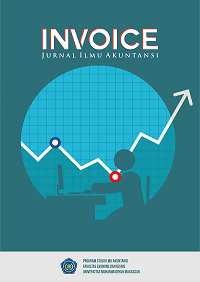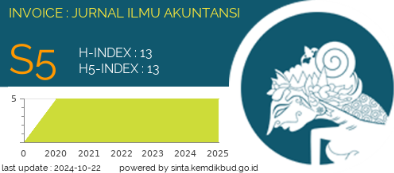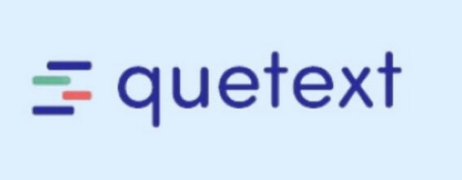Time Budget Pressure and Psychological Traits as Predictors of Dysfunctional Auditor Behavior
Abstract
This study investigates the influence of external locus of control, time budget pressure, and professional skepticism on dysfunctional auditor behavior in public accounting firms (KAPs) located in Makassar, Indonesia. Dysfunctional auditor behavior—such as premature sign-offs, underreporting of time, and superficial audit procedures—can undermine audit quality and threaten the integrity of financial reporting. Understanding the behavioral factors that contribute to such unethical practices is crucial for enhancing audit effectiveness. A quantitative research design was employed using primary data collected through structured questionnaires distributed to 40 auditors from various KAPs. The data were analyzed using multiple linear regression to test the relationships among variables. The results reveal that both external locus of control and time budget pressure have a positive and significant impact on dysfunctional auditor behavior. This implies that auditors who attribute outcomes to external factors or experience excessive workload and tight deadlines are more prone to compromise professional standards. Conversely, professional skepticism has a negative and significant effect, suggesting that higher levels of skepticism can reduce the likelihood of dysfunctional actions. The findings highlight the need for audit firms to strengthen professional skepticism through targeted training and to manage time pressures to reduce unethical behavior. This study offers practical implications for regulators, firms, and audit educators.
References
Agoes, S., & Ardana, C. (2013). Business and professional ethics: The challenge of building a whole human being. Jakarta: Salemba Empat.
Alkautsar, M. (2014). Locus of control, professional commitment, and dysfunctional audit behavior. International Journal of Humanities and Management Sciences, 2(1), 30–34.
Arens, A. A., Elder, R. J., & Beasley, M. S. (2017). Auditing and assurance services: An integrated approach (16th ed.). New Jersey: Pearson.
Chairunnisa, D., Zulbahridar, & Idrus, R. (2014). The influence of locus of control, organizational commitment, and professional commitment on dysfunctional audit behavior with auditor performance as an intervening variable. JOM FE Universitas Riau, 1(2), 1–15.
Dewi, N. M., & Wirasedana, I. W. P. (2015). The influence of time budget pressure, locus of control, and task complexity on dysfunctional audit behavior. E-Jurnal Akuntansi Universitas Udayana, 10(2), 460–472.
Donnelly, P. D., Quirin, J. J., & O'Bryan, D. (2003). Auditor acceptance of dysfunctional audit behavior: An explanatory model using auditor's personal characteristics. Behavioral Research in Accounting, 15(1), 87–110.
Falk, R. F., & Miller, N. B. (1992). A primer for soft modeling. Akron, OH: University of Akron Press.
Fitriani, S., & Aswar, K. (2022). The effect of time budget pressure, professional commitment, and locus of control on dysfunctional audit behavior. Journal of Economics and Business Letters, 2(3), 144–150. https://doi.org/10.55942/jebl.v2i3.264
Ghozali, I. (2014). Structural equation modeling: Metode alternatif dengan partial least square (PLS) (Edisi 4). Semarang: Badan Penerbit Universitas Diponegoro.
Ghozali, I., & Latan, H. (2015). Partial least squares: Konsep, teknik dan aplikasi menggunakan SmartPLS 3.0. Semarang: Badan Penerbit Universitas Diponegoro.
Hair, J. F., Hult, G. T. M., Ringle, C. M., & Sarstedt, M. (2014). A primer on partial least squares structural equation modeling (PLS-SEM). Thousand Oaks, CA: Sage Publications.
Indriantoro, N., & Supomo, B. (2002). Metodologi penelitian bisnis: Untuk akuntansi dan manajemen. Yogyakarta: BPFE Yogyakarta.
Kreitner, R., & Kinicki, A. (2005). Organizational behavior (5th ed.). New York: McGraw-Hill.
Margaretha, F. (2011). Perilaku disfungsional auditor: Sebuah studi empiris. Jurnal Akuntansi dan Keuangan Indonesia, 8(2), 123–141.
Nasution, A. D., & Fitriany. (2012). Dysfunctional behavior of auditors: Review from the perspective of love of money, Machiavellian traits, and locus of control. Simposium Nasional Akuntansi XV, Banjarmasin.
Nasser, S. A. (2022). The influence of locus of control and time budget pressure on auditors’ dysfunctional behavior in Aceh Inspectorate. Journal of Economics and Business Letters, 2(2), 105–113.
Puspasari, N., & Suwardi, E. (2016). The effect of individual morality and internal control on the propensity to commit fraud: Evidence from local governments. Journal of Indonesian Economy and Business, 31(2), 208–219. https://doi.org/10.22146/jieb.10320
Putri, V. A. W. (2021). The effect of time budget pressure, turnover intention, and auditor motivation on dysfunctional audit behavior (Study at the Public Accounting Firm in Pekanbaru). JOM FE Universitas Riau, 8(1), 1–15.
Rita, M., & Wahyuni, S. (2021). The influence of time budget pressure, obedience pressure, and locus of control on auditor’s dysfunctional behavior. Journal of Applied Business and Accounting, 7(1), 21–30. https://doi.org/10.33508/jaba.v7i1.3157
Rustiarini, N. W. (2013). Fraud diamond: Detection of fraud tendency. Jurnal Akuntansi Multiparadigma, 4(3), 353–370.
Setyawati, I., Haryanto, H., & Titisari, K. H. (2022). The influence of work stress, locus of control, and turnover intention on dysfunctional behavior of internal auditors (Case study at Inspectorate General of Ministry of Agriculture). Jurnal Akuntansi dan Keuangan, 24(2), 62–77. https://doi.org/10.9744/jak.24.2.62–77
Sugiyono. (2015). Metode penelitian kuantitatif, kualitatif dan R&D. Bandung: Alfabeta.
Yanti, H. R. (2015). The influence of auditor’s understanding of good governance, auditor ethics, and auditor experience on audit quality with locus of control as a moderating variable. Jurnal Akuntansi dan Keuangan, 6(1), 10–25.
Downloads
Published
Issue
Section
License
Authors who publish with Invoice: Jurnal Ilmu Akuntansi agree to the following terms:
-
Copyright Ownership
The copyright of all articles published in this journal remains with the author(s). However, the authors grant Invoice: Jurnal Ilmu Akuntansi the right of first publication with the work simultaneously licensed under a Creative Commons Attribution 4.0 International License (CC BY 4.0). This license allows others to share, copy, redistribute, adapt, and build upon the work for any purpose, even commercially, as long as proper credit is given to the original author(s) and the source. -
Licensing and Access
Invoice: Jurnal Ilmu Akuntansi provides immediate open access to its content on the principle that making research freely available to the public supports a greater global exchange of knowledge. All published materials are available freely without subscription or payment and can be accessed, downloaded, and reused by any user provided that appropriate attribution is given. -
Permission for Reuse
For uses not covered by the CC BY 4.0 license, such as commercial reprints, translations, or any form of adaptation without clear attribution, users must obtain written permission from the editorial team. Requests for such permissions can be directed to the editorial office at: [invoice@unismuh.ac.id]. -
Plagiarism and Originality
Authors are responsible for the originality of their submissions. All articles are screened for plagiarism using appropriate tools before acceptance. Manuscripts found to contain unoriginal content or infringing materials will be rejected or retracted as per journal policy.














